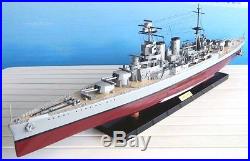

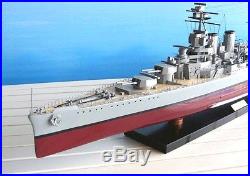
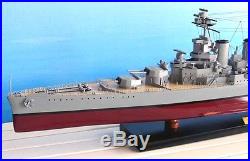

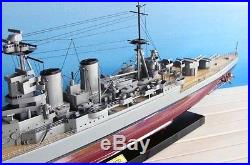
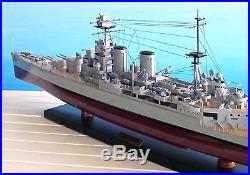
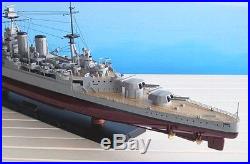

HMS Hood (pennant number 51) was the last battle cruiser built for the Royal Navy. Commissioned in 1920, she was named after the 18th-century Admiral Samuel Hood. One of four Admiral-class battlecruisers ordered in mid-1916, Hood had serious design limitations, though her design was drastically revised after the Battle of Jutland and improved while she was under construction. As one of the largest and, ostensibly, the most powerful warships in the world, Hood was the pride of the Royal Navy and, carrying immense prestige, was known as The Mighty Hood. Hood was involved in several showing the flag exercises between her commissioning in 1920 and the outbreak of war in 1939, including training exercises in the Mediterranean Sea and a circumnavigation of the globe with the Special Service Squadron in 1923 and 1924. She was attached to the Mediterranean Fleet following the outbreak of the Second Italo-Abyssinian War. When the Spanish Civil War broke out, Hood was officially assigned to the Mediterranean Fleet until she had to return to Britain in 1939 for an overhaul. By this time, advances in naval gunnery had reduced Hood’s usefulness. When war with Germany was declared, Hood was operating in the area around Iceland, and she spent the next several months hunting between Iceland and the Norwegian Sea for German commerce raiders and blockade runners. After a brief overhaul of her propulsion system, she sailed as the flagship of Force H, and participated in the destruction of the French Fleet at Mers-el-Kebir. Relieved as flagship of Force H, Hood was dispatched to Scapa Flow, and operated in the area as a convoy escort and later as a defence against a potential German invasion fleet. In May 1941, she and the battleship Prince of Wales were ordered to intercept the German battleship Bismarck and the heavy cruiser Prinz Eugen, which were en route to the Atlantic where they were to attack convoys. On 24 May 1941, early in the Battle of the Denmark Strait, Hood was struck by several German shells, exploded and sank. Due to her perceived invincibility, the loss had a profound effect on the British people. It was more thorough than the first board and concurred with the first board’s conclusion. Other historians have concentrated on the cause of the magazine explosion. 40″ (long) x 5″ (wide) x 11.5 (high). Our models are 100% hand built from scratch by skillful master craftsmen, ready to display and not from any sort of kit. We use the plank-on-frame method to build our models. The model has been made from finest woods and metals. The model is a perfect gift for home or office decoration, boat enthusiast or passionate collectors. All items are in stock when they are listed. Inventory is tracked and updated regularly. We will offer other items in similar style and quality. First and allow us the opportunity to help you and be sure we have what you\’re looking for. Packing: Items are securely packed peanuts or bubble wraps. Your satisfaction is guaranteed! The item “1920 HMS HOOD British Royal Navy Battle Cruiser 40 Wood Model Military Ship” is in sale since Sunday, December 13, 2015. This item is in the category “Collectibles\Transportation\Boats & Ships\Military\Models”. The seller is “atlantisgift” and is located in Staten Island, New York. This item can be shipped to North, South, or Latin America, to all countries in Europe, to all countries in continental Asia, to Australia.
- Country/Region of Manufacture: Vietnam
- Brand: SW
- MPN: BS005
- Model: HMS HOOD British Royal Navy Battleship
- Size: 40″ (long) x 5″ (wide) x 11.5″ (high).
- Material: Wood and metal
- Constraction: plank-on-frame method
- Specific Type: Fully Assembled Tall Ship model

